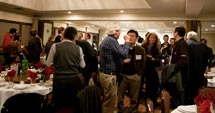
Handy Links
SLAC News Center
SLAC Today
- Subscribe
- Archives: Feb 2006-May 20, 2011
- Archives: May 23, 2011 and later
- Submit Feedback or Story Ideas
- About SLAC Today
SLAC News
Lab News
- Interactions
- Lightsources.org
- ILC NewsLine
- Int'l Science Grid This Week
- Fermilab Today
- Berkeley Lab News
- @brookhaven TODAY
- DOE Pulse
- CERN Courier
- DESY inForm
- US / LHC
SLAC Links
- Emergency
- Safety
- Policy Repository
- Site Entry Form

- Site Maps
- M & O Review
- Computing Status & Calendar
- SLAC Colloquium
- SLACspeak
- SLACspace
- SLAC Logo
- Café Menu
- Flea Market
- Web E-mail
- Marguerite Shuttle
- Discount Commuter Passes
-
Award Reporting Form
- SPIRES
- SciDoc
- Activity Groups
- Library
Stanford
Around the Bay
Fermi Large Area Telescope Collaboration Back at SLAC for Upbeat Meeting
Nearly 200 members of the Fermi Gamma-ray Space Telescope–Large Area Telescope Collaboration converged on SLAC last week to attend the biannual collaboration meeting. A meeting filled with good news took on an extra air of celebration thanks to the January announcement that UC Santa Cruz particle astrophysicist Bill Atwood, LAT principal investigator Peter Michelson and the entire Fermi-LAT team had received the Bruno Rossi Prize.
"The observatory is operating smoothly and almost exclusively in nominal survey mode," said Fermi Project Scientist Julie McEnery of NASA during a status update on the mission as a whole. In other words, the observatory is spending the majority of its time scanning the skies for sources of highly-energetic gamma rays and refining its catalogue, which is just as it should be, according to McEnery.
"In general, you don't want to point" at specific areas of the sky, she explained. "You want to see amazing events, but amazing events don't happen very often and you don't know where they'll happen next. The best way to catch them is to look at everything all the time."
In the course of looking at everything all the time—actually, surveying the whole sky every three hours—the LAT has registered 164 billion interesting signals. Most were from cosmic rays, but the LAT has an onboard filter capable of distinguishing between those and the gamma rays it seeks. Even with the cosmic ray data removed, the LAT downloads 130 gigabits of data a day, SLACer Gregg Thayer said during his status update on telescope function. Thayer is responsible for operational settings onboard the LAT and serves as the interface between the science groups in the collaboration and LAT operations.
According to Thayer, the telescope is up to the data-collecting and data-handling tasks. "If you don't have real problems, you have to make stuff up," he quipped as he presented a list of minor performance issues, calling them instead "items of mild interest." According to Thayer, the slide underscored the impressive performance of LAT operations.
The general air of celebration was especially noticeable at the team dinner on Wednesday evening.
"This is a celebration of our collaboration and our friends who helped us build [the LAT]," Michelson said of the packed dining room. "The science is fabulous and has been from the start." McEnery said she doesn't want the team to rest on past accomplishments, though. Fermi's primary mission doesn't end until August, 2013 but she said the team needs to be ready for a NASA Senior Review process in 2012 that will evaluate the mission for operations beyond the five-year primary plan.
"Even as we celebrate the success of the mission and the science it has produced, we need to keep looking to the future and asking questions that Fermi can help answer," McEnery said. "Some of them are new questions that we didn't even know to ask at the beginning of the mission. "
—Lori Ann White
SLAC Today, March 14, 2011
